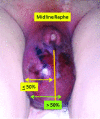Early scrotal approximation after hemiscrotectomy in patients with Fournier's gangrene prevents scrotal reconstruction with skin graft
- PMID: 23914264
- PMCID: PMC3713146
- DOI: 10.5489/cuaj.1405
Early scrotal approximation after hemiscrotectomy in patients with Fournier's gangrene prevents scrotal reconstruction with skin graft
Abstract
Objective: We report the outcomes of an early loose closure of the scrotum with a modified U-stitch to minimize use of split thickens skin graft for patients with hemiscrotal tissue loss after surgical debridement.
Methods: From January 2006 to August 2011, 28 male patients presented with Fournier's gangrene, requiring major urological surgical care and scrotal debridement at Denver Health Medical Center. Surgical outcomes were compared between patients receiving a novel U-Stitch approximation and those treated by traditional management.
Results: The mean age of the patients was 47.1 ± 10.2 years. In total 8 patients (2.2%) developed bacteremia and 3 (0.1%) had methicillin-resistant staphylococcus aureus (MRSA) infection. There was conversion from the U-Stitch approximation patients to traditional management. U-stitch patients required less hospitalization than patients requiring split-thickness skin graft (STSG) due to loss of >50% of the total scrotal tissue (11 vs. 35 days, p = 0.081). The U-stitch demonstrated non-inferiority to traditional treatment.
Conclusion: Immediate loose scrotal wound approximation with efficient surgical debridement for Fournier's gangrene may prevent testis exposure facilitating local wound treatment, decreasing the length of hospital stay in patients with Fournier's gangrene involving the scrotum. Future randomized trials may validate these findings.
Figures
References
LinkOut - more resources
Full Text Sources
Other Literature Sources


